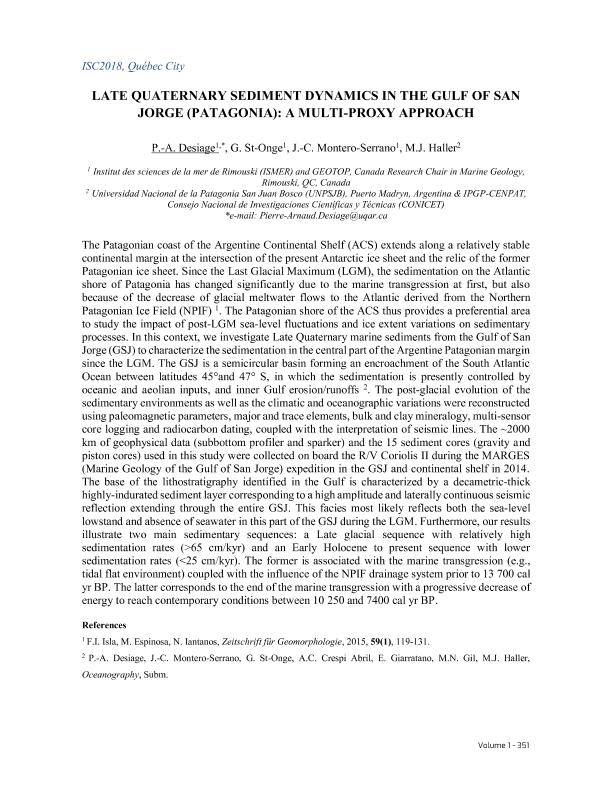Mostrar el registro sencillo del ítem
dc.contributor.author
Desiage, P. A.
dc.contributor.author
Onge, G.
dc.contributor.author
Montero Serrano, J. C.
dc.contributor.author
Haller, Miguel Jorge F.

dc.date.available
2021-06-15T12:53:28Z
dc.date.issued
2018
dc.identifier.citation
Late Quaternary sediment dynamics in the Gulf of San Jorge (Patagonia): A multi-proxy approach; 20th International Sedimentological Congress; Quebec; Canadá; 2018; 351-351
dc.identifier.isbn
978-2-89146-936-4
dc.identifier.uri
http://hdl.handle.net/11336/133875
dc.description.abstract
The Patagonian coast of the Argentine Continental Shelf (ACS) extends along a relatively stable continental margin at the intersection of the present Antarctic ice sheet and the relic of the former Patagonian ice sheet. Since the Last Glacial Maximum (LGM), the sedimentation on the Atlantic shore of Patagonia has changed significantly due to the marine transgression at first, but also because of the decrease of glacial meltwater flows to the Atlantic derived from the Northern Patagonian Ice Field (NPIF) 1. The Patagonian shore of the ACS thus provides a preferential area to study the impact of post-LGM sea-level fluctuations and ice extent variations on sedimentary processes. In this context, we investigate Late Quaternary marine sediments from the Gulf of San Jorge (GSJ) to characterize the sedimentation in the central part of the Argentine Patagonian margin since the LGM. The GSJ is a semicircular basin forming an encroachment of the South Atlantic Ocean between latitudes 45°and 47° S, in which the sedimentation is presently controlled by oceanic and aeolian inputs, and inner Gulf erosion/runoffs 2. The post-glacial evolution of the sedimentary environments as well as the climatic and oceanographic variations were reconstructed using paleomagnetic parameters, major and trace elements, bulk and clay mineralogy, multi-sensor core logging and radiocarbon dating, coupled with the interpretation of seismic lines. The ~2000 km of geophysical data (subbottom profiler and sparker) and the 15 sediment cores (gravity and piston cores) used in this study were collected on board the R/V Coriolis II during the MARGES (Marine Geology of the Gulf of San Jorge) expedition in the GSJ and continental shelf in 2014. The base of the lithostratigraphy identified in the Gulf is characterized by a decametric-thick highly-indurated sediment layer corresponding to a high amplitude and laterally continuous seismic reflection extending through the entire GSJ. This facies most likely reflects both the sea-level lowstand and absence of seawater in this part of the GSJ during the LGM. Furthermore, our results illustrate two main sedimentary sequences: a Late glacial sequence with relatively high sedimentation rates (>65 cm/kyr) and an Early Holocene to present sequence with lower sedimentation rates (<25 cm/kyr). The former is associated with the marine transgression (e.g., tidal flat environment) coupled with the influence of the NPIF drainage system prior to 13 700 cal yr BP. The latter corresponds to the end of the marine transgression with a progressive decrease of energy to reach contemporary conditions between 10 250 and 7400 cal yr BP.
dc.format
application/pdf
dc.language.iso
eng
dc.publisher
International Association of Sedimentogists
dc.rights
info:eu-repo/semantics/openAccess
dc.rights.uri
https://creativecommons.org/licenses/by-nc-sa/2.5/ar/
dc.subject
ARGENTINE CONTINENTAL SHELF
dc.subject
SEA-LEVEL FLUCTUATIONS
dc.subject
OCEANIC INPUT
dc.subject
EOLIAN INPUT
dc.subject.classification
Oceanografía, Hidrología, Recursos Hídricos

dc.subject.classification
Ciencias de la Tierra y relacionadas con el Medio Ambiente

dc.subject.classification
CIENCIAS NATURALES Y EXACTAS

dc.title
Late Quaternary sediment dynamics in the Gulf of San Jorge (Patagonia): A multi-proxy approach
dc.type
info:eu-repo/semantics/publishedVersion
dc.type
info:eu-repo/semantics/conferenceObject
dc.type
info:ar-repo/semantics/documento de conferencia
dc.date.updated
2021-04-27T13:33:10Z
dc.journal.volume
1
dc.journal.pagination
351-351
dc.journal.pais
Canadá

dc.journal.ciudad
Quebec
dc.description.fil
Fil: Desiage, P. A.. Institut des Sciences de la Mer de Rimouski; Canadá
dc.description.fil
Fil: Onge, G.. Institut des Sciences de la Mer de Rimouski; Canadá
dc.description.fil
Fil: Montero Serrano, J. C.. Institut des Sciences de la Mer de Rimouski; Canadá
dc.description.fil
Fil: Haller, Miguel Jorge F.. Universidad Nacional de la Patagonia "San Juan Bosco"; Argentina. Consejo Nacional de Investigaciones Científicas y Técnicas. Centro Científico Tecnológico Conicet - Centro Nacional Patagónico. Instituto Patagónico de Geología y Paleontología; Argentina
dc.relation.alternativeid
info:eu-repo/semantics/altIdentifier/url/http://espace.inrs.ca/id/eprint/9682/1/L445v.1.pdf
dc.conicet.rol
Autor

dc.conicet.rol
Autor

dc.conicet.rol
Autor

dc.conicet.rol
Autor

dc.coverage
Internacional
dc.type.subtype
Congreso
dc.description.nombreEvento
20th International Sedimentological Congress
dc.date.evento
2018-08-13
dc.description.ciudadEvento
Quebec
dc.description.paisEvento
Canadá

dc.type.publicacion
Book
dc.description.institucionOrganizadora
International Association of Sedimentogists
dc.description.institucionOrganizadora
Society for Sedimentary Geology
dc.source.libro
Book of abstacts: 20th International Sedimentological Congress
dc.date.eventoHasta
2018-08-17
dc.type
Congreso
Archivos asociados
